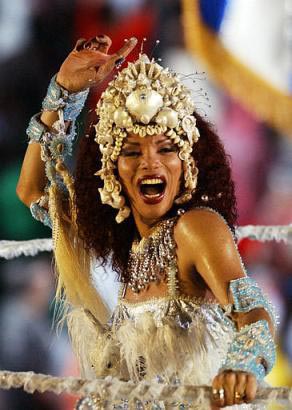Carnival: More than Rio
 References to the Carnival in Rio demonstrate lack of understanding regarding one of Brazil's most famous cultural exports
References to the Carnival in Rio demonstrate lack of understanding regarding one of Brazil's most famous cultural exports
That Rio de Janeiro is one of the most beautiful pearls in the Atlantic Ocean, let there be no doubt. That the Carnival is Brazil's main cultural export, nonsense. The Carnival is one of Brazil's many cultural references, which range from literature to the plastic arts, from sport to dance and music. The Carnival is but one manifestation of the last two areas of cultural expression.
Yet the international press is full of references to Rio at Carnival time and the fact that many people associate Brazil with the Carnival and nothing else hides a truth which needs to be exposed. Firstly, the Carnival is more than Rio and secondly, Brazil is much more than the Carnival.
Firstly, what is the Carnival?
It is said that the origin of the word is the Latin “Carnis vale”, or “Goodbye to meat” due to the fact that the date coincides with Shrove (Confession) Tuesday, the day before the first day of Lent in the Roman Catholic calendar, Ash Wednesday. It was supposed to make sacrifices, abstaining from eating meat during this period, as a demonstration of respect for the suffering of Jesus Christ.
The calculation of the date is somewhat complicated. First it is necessary to set the first day of Spring and find the first Full Moon after this. The Sunday following the first Full Moon of Spring is Easter Sunday and to arrive at Carnival or Shrove Tuesday, it is necessary to count back 40 days, which sets the date for Ash Wednesday. The Carnival takes place the day before, or in Brazil's case, the weekend before.
It is important to point out that the Carnival is not only in Rio de Janeiro, but takes place all over Brazil, although the samba schools in Rio have learnt how to corner the TV market, due to the media interest in the Sambodrome.
Each samba school chooses the theme for the procession. In some cases, these are political themes, in others they are ecological or in others, humorous. For example, a Samba school in Sao Paulo this year chose the theme of Larry Rohter, the New York Times correspondent who stated that President Lula was an alcoholic, drinking too much cachassa (sugar cane spirit), before saying that the story about the beauty of Brazilian women was a myth and after complaining that the Brazilian authorities were irresponsible over the Amazon.
The lyrics of the refrain are:
Ele nao gosta de cachassa
Ele nao gosta de mulher
Sera que ele e?
Sera que ele e?
He does not like cachassa
He does not like women
Could it be that he is………?
Could it be that he is………?
The dresses and costumes and dances of the school are based around the theme chosen.
The music and dance which accompanies the Carnival is called Samba.
The dance is based around quick movements of the feet in a rhythm which involves the rest of the body in a sexual-simulation evocative of the fertility festival which the occasion reflects: the awakening of the agricultural season and the end of winter.
Samba is in fact a combination of African, Native Brazilian and European dance modes, meaning “pray” to the personal God or Saint (Orixa) and the rhythms used in Samba reflect those used in the African populations from where the slaves were taken (Yoruba, Congo and other West African civilizations).
Over the centuries, this originally ethnic dance was assimilated with European practices, seeing people dance to a rhythm in a circle, being called Zemba Queca in the 1880s in Brazil and then later, Mesemba (Samba).
Subscribe to Pravda.Ru Telegram channel, Facebook, RSS!




